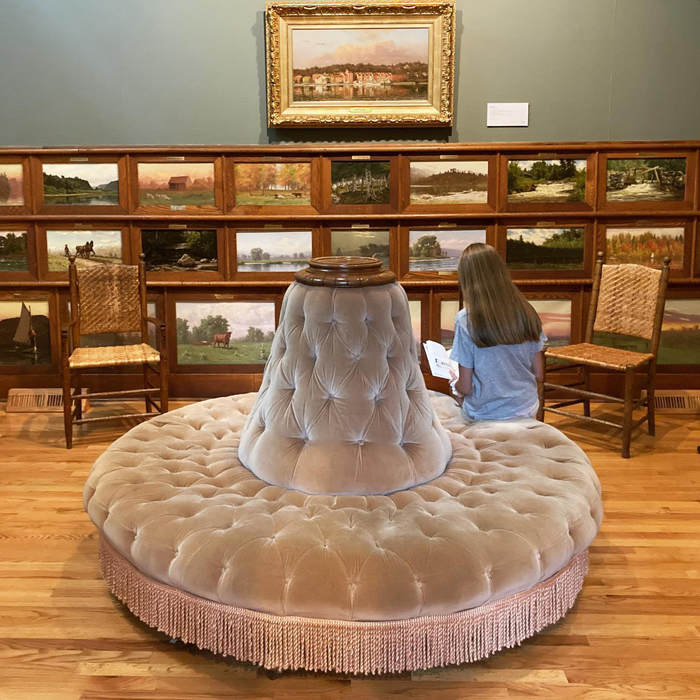
There is much to love at the Barrow Gallery, but one of my favorite features is the circular sofa, the borne settee, the divan de milieu. And I am not alone.
In 1986, Mae Lanning Watkins, who grew up in Skaneateles, revisited the Barrow Gallery and the local press noted, “As youngsters, of course, they appreciated the beautiful oil paintings but a more vivid memory was that of the circular divan on which they used to very properly sit and observe the art collection. Mrs. Watkins was delighted to discover that very same piece of furniture is still located in the center of the gallery. She immediately became comfortable on the settee as she had about 70 years ago.”
From whence cometh the memorable and inviting circular divan?
In Culture & Comfort: Parlor Making and Middle-Class Identity, 1850-1930, Katherine Grier describes the circular divan as a bourne, “the large, round, fabric-covered couch designed to occupy the center of rooms. The bourne was a French innovation, its design a reflection of the ‘Turkish taste’ which was one aspect of French decor throughout the nineteenth century.”
Initially, the bourne was a way to provide seating in public spaces, such as hotel lobbies, railroad stations and reception halls. But the borne also took a more stylish turn. At London’s Great Exhibition of 1851, the French firm of Maison Balny Jeune exhibited a circular divan.
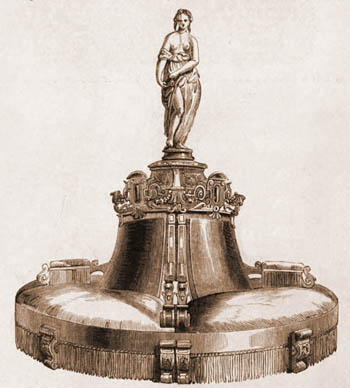
The Art Journal praised its “very elegant and novel mode of treating an article of furniture which, in general, has nothing to recommend it but unadorned utility… [They have] shown how such objects may be made elegant and artistic, by using the centre of the ottoman as a pedestal for a statue; the idea has both novelty and ingenuity to recommend it.”
The adorned circular settee began making appearances in literature. In Gustave Flaubert’s Sentimental Education (1869), he described the home of a Parisian banker. “Under the chandelier, was a vast circular sofa, surrounding a jardiniere full of flowers, which nodded like plumes and overhung the heads of the women sitting round it.”
Likewise, Émile Zola in His Excellency Eugène Rougon (1876) wrote about a bazaar in the Orangery at the Tuileries in Paris. “There was a low circular velvet settee, with a very sloping back; and in the centre of this circular settee a huge column of flowers shot up, a pillar of stems amongst which hung roses, carnations and verbenas, like a rain of gleaming drops.”
In 1875, a contributor to The Gentleman’s Magazine wrote of his visit to the annual Salon art exhibit in Paris: “A circular ottoman of hospitable dimensions stands in the centre of the lobby, enabling the visitor to enjoy a little fresh air and quietly watch the ascent into the show-rooms of a motley public.”

Crossing the Atlantic for the 1876 Centennial Exposition in Philadelphia, the French exhibited a “remarkable circular settee.” In “Gems of the Centennial Exhibition,” George Ferris described this gargantuan interpretation:
“The settee is fourteen feet high and ten feet in diameter. It is in the Renaissance style and is composed at the base of a circular sofa, covered in green satin, and divided into four parts by bronze arms of the color of old silver on a base of gold. These arms terminate at the bottom with extended wings, serving as rests, and at the top in bunches of lights supported by caryatides. They are united by a bronze frieze, which crowns the back of the sofa. Above the sofa rises an antique fountain of red marble and bronze. The jet is enclosed in a graceful cupola supported by four symmetric Ionian columns. The water flows over marble steps and falls first into a basin of bronze, from which it is thrown, by six jets from the mouths of fantastic figures, into a lower basin. Finally, the whole is gracefully surmounted by a chandelier of fifty burners.”
Wow.
In “The Secret History of the Conversation Chair,” Vanessa at Messy Nessy Chic has written this about the circular settee in 19th century America: “Virtually no mansion of the Gilded Age was complete without the borne settee. How better for the newly rich barons to show off their gilded rooms filled with art, than with 360-degree museum-style seating? Guests could marvel at the room by facing any point on the compass while discretely gossiping about their host at the same time.”
![[Art Gallery in the Astor Mansion, 34th Street and 5th Avenue.]](https://kihm6.files.wordpress.com/2022/12/astor-settee.jpg)
Leading the way, was The Mrs. Astor (emphasis hers), Caroline “Lina” Astor, who inherited and married money. She built a glamorous multistory townhouse at New York City’s Fifth Avenue and 34th Street, which became the site of numerous elaborate parties, including an annual ball. Caroline Astor’s ballroom could comfortably accommodate 400 guests, and it doubled as her art gallery, complete with a circular settee.
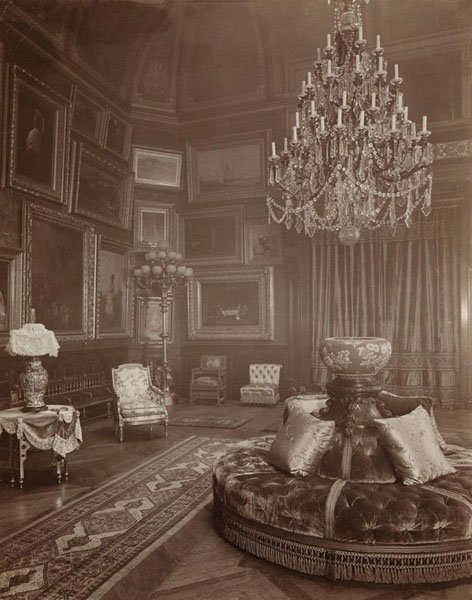
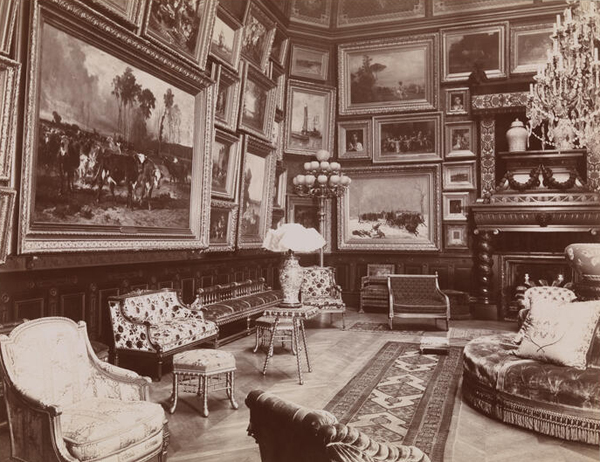
Mrs. Astor was not alone. The print gallery in James L. Claghorn’s house in Philadelphia also had a circular divan:
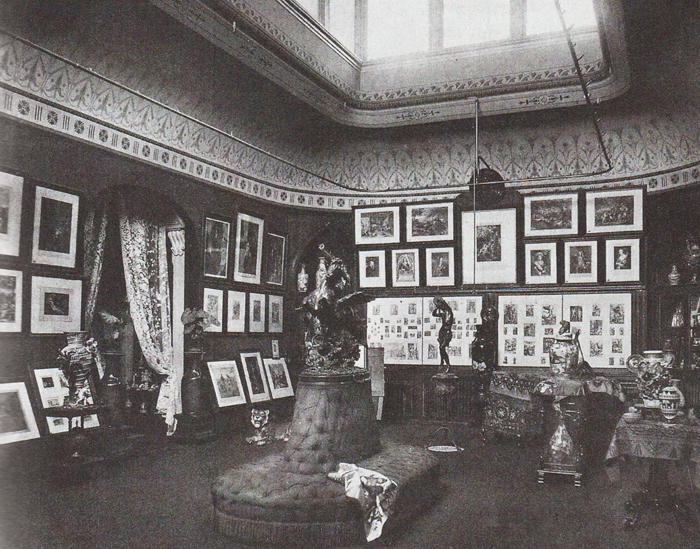
A variation on the theme was the four-sided sofa, seen below in the New York City homes of Mary Stuart and of William Vanderbilt:
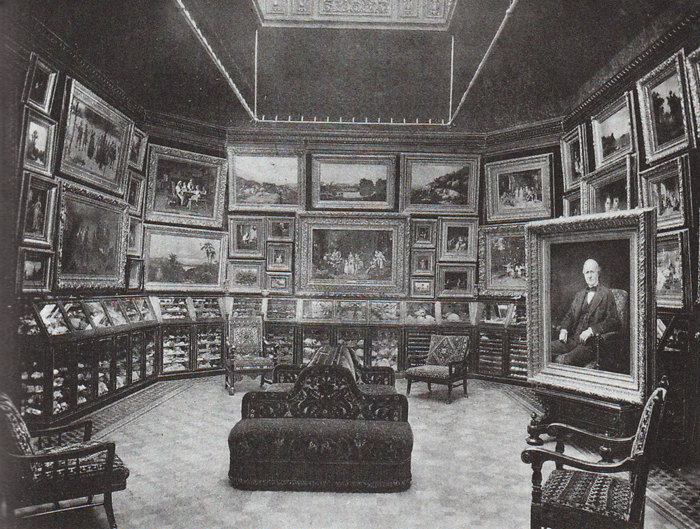
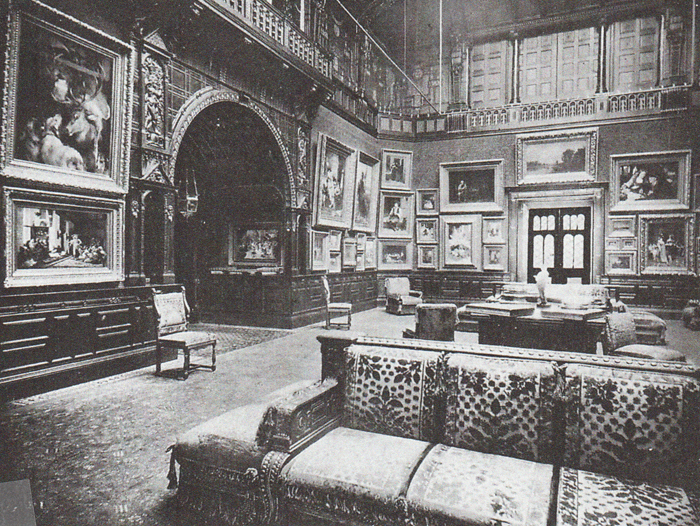
On to Skaneateles and John Barrow’s gallery. A 1907 photograph, below, shows the circular settee in place, enabling visitors to sit and view the collection from any angle.

The settee has been twice refurbished, in 1977 and more recently, and today holds court, invites you to sit properly, and enjoy.
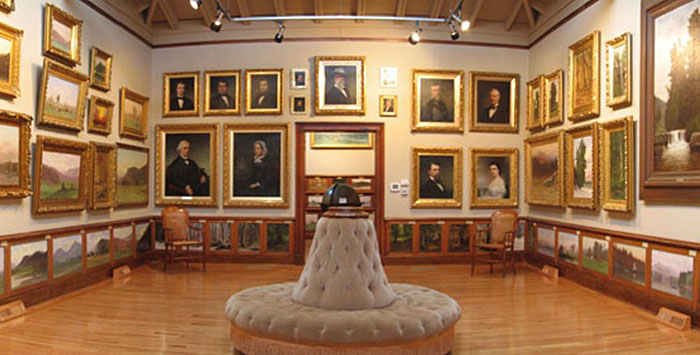
***
The Barrow Gallery is located at the corner of Genesee and State Streets, in the heart of Skaneateles. It is the brick annex attached to the Skaneateles Library, and the gallery entrance is located on State Street.
The gallery is closed January through April, and open May through December; the hours are Thursday through Sunday, 1-4 p.m.
***
Selected Sources
The Art-Journal Illustrated Catalogue: The Industry of All Nations, 1851. London: George Virtue, 1851.
The Centennial Exposition, Described and Illustrated. Philadelphia: Hubbard Bros., 1876.
“Former Resident Shows Village to Relative,” Press-Observer, September 3, 1986
The Opulent Interiors of the Gilded Age (2016) by Arnold Lewis, James Turner & Steven McQuillin
“The Secret History of the Conversation Chair” by MessyNessy, January 30, 2020
“The Bourne Identity: What Was the Ottoman For, and Where Does It Belong?” by Lisa Schinhofen


